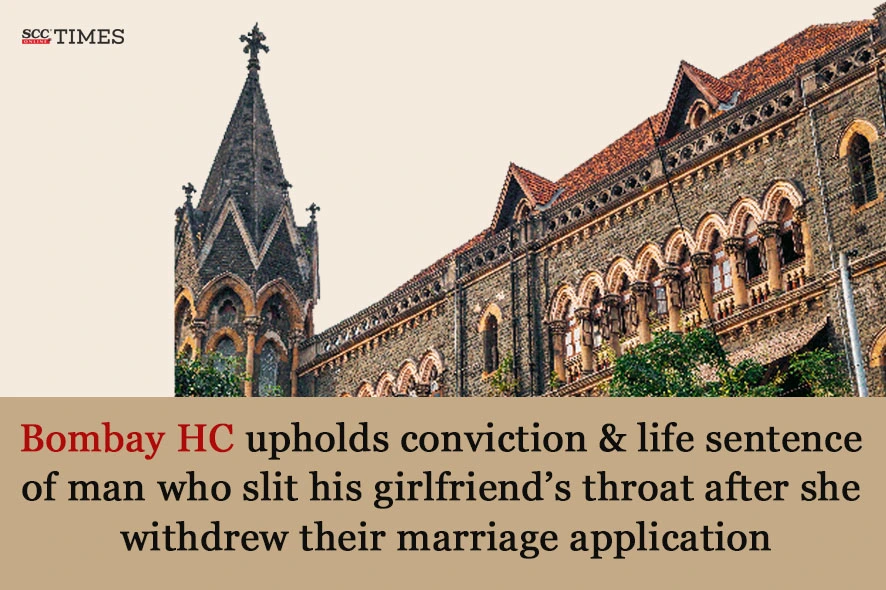Bombay High Court: In the present criminal appeal, the appellant-accused challenged the order passed by the Additional Sessions Judge (‘Trial Court’) convicting him under Sections 302 and 309 of the Penal Code, 1860 (‘IPC’) for murdering his girlfriend (‘victim’) and sentencing him to rigorous life imprisonment. The Division Bench of Sarang V. Kotwal* and Shyam C. Chandak, JJ., opined that since the accused was the only one present in the room along with the deceased victim and there was no one else who could have committed the offence; therefore, there was no possibility of any other hypothesis but to accept that it was only the accused who could have committed this offence. Hence, the Court dismissed the appeal.
Background:
The accused and the victim were in a relationship and had given notice of their marriage. The victim’s family persuaded her to withdraw the notice and promised that they would get her married to the accused after her elder sister’s marriage. On 18-5-2016, at about 08:30 p.m., the couple met in a nearby school and some boys heard shouts coming from a classroom. Upon reaching there, they saw the victim lying in a pool of blood, and the accused was also lying nearby. There was a cutter at the spot, too. The boys ran outside and informed other people as well as the victim’s mother. By the time the police arrived, the victim had succumbed to her injuries, and the accused was taken to the hospital.
The accused alleged that the victim had withdrawn their marriage application, as her family was opposed to the marriage because he had not taken any higher education and was only a truck driver. A few days prior to the incident, the victim visited her sister’s matrimonial home where she was told that they would not get her married to the accused. The accused further pleaded that on 18-5-2016, when they met in the school, she told him that she would not live without him and said that they had no other option than to commit suicide to which the accused agreed. Being under immense mental pressure the accused and the victim allegedly decided to commit suicide. The accused specifically submitted that he took the cutter from the victim’s hand and inflicted blows on his wrist and neck and became unconscious, and therefore, he did not know what happened after that.
However, the prosecution stated that the accused had inflicted cuts on the victim’s throat with a cutter and caused other injuries as well. The victim’s mother deposed that on the day of the incident, the victim spoke to her sister on call and then she went outside the house. The mother went searching for her and when she saw a crowd near the school, she went there and saw her daughter lying in a pool of blood with her throat cut open. The accused was lying there and when the people approached to help him, he told them not to touch him and added that he had killed the victim and that he also wanted to die. She alleged that the accused was angry at the victim for withdrawing the marriage application and had threatened her that he would commit suicide and would kill her too. The victim had narrated all these facts to her mother. The elder sister and her husband also deposed on similar lines.
The post-mortem report of the victim mentioned 18 injuries and the opinion as to the cause of death was ‘hemorrhagic shock due to cut-throat injuries’ and the doctor stated that the injuries were possible if inflicted by another person and they were not self-inflicted as some of them were even defence wounds. Regarding the wounds of the accused, it was opined that the injuries on his wrist could be self-inflicted.
Therefore, the Trial Court held that there was no reason for an educated girl like the victim to commit suicide when she had the option of leaving the house and marrying the accused and relying upon the evidence adduced, recorded the guilt of the accused and convicted him and sentenced him to life imprisonment.
Analysis and Decision:
The Court analysed the post-mortem evidence and concluded that there were nine injuries of quite some length on the victim’s neck, and it was impossible that after one or two such injuries caused by the victim herself, she would be able to inflict more incised wounds on her own neck. There were also defence wounds on her palm, so the injuries were not caused pursuant to the plan to end their lives together. The Court also observed that it was quite clear that only after the accused started inflicting blows with the cutter on the victim that she shouted, thereby attracting the attention of the people nearby.
The Court opined that the specific defence of the accused was not that the victim died because of his assault, rather it was that he inflicted injuries on himself and lost consciousness. Firstly, he suggested that the victim had committed suicide by inflicting those injuries on herself and secondly, he feigned ignorance about what happened after he inflicted those injuries on himself. Since only two persons could have narrated about the incident and the victim was dead, therefore under Section 106 of the Evidence Act, 1872, the burden was on the accused to explain under what circumstances the deceased had suffered those injuries.
The Court observed that the accused could not discharge the burden placed on him, and there was no other person present to commit the offence, proving that it was only the accused who could have done that. Consequently, the Court held that since the prosecution had proved its case beyond reasonable doubt, the appeal stood dismissed.
[Shashikant Shantaram Tavare v. State of Maharashtra, 2025 SCC OnLine Bom 2567, decided on 3-7-2025]
*Judgment authored by: Justice Sarang V. Kotwal
Advocates who appeared in this case :
For the Appellant: Ramesh Dube Patil a/w. Sagar Kasar, Rishabh Tiwari, Chaitali Bhogle and Iraa Dube Patil.
For the Respondent: Kranti T. Hiwrale, APP.




